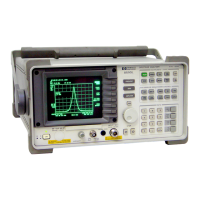Chapter 11 537
Synthesizer Section
Unlocked Reference PLL (100 MHz VCXO)
Unlocked Reference PLL (100 MHz VCXO)
Operation (100 MHz VCXO)
The 600 MHz reference is generated by tripling, then doubling the
output of the 100 MHz phase-locked loop. If the 600 MHz reference is
off frequency, the 100 MHz phase-lock circuitry is probably at fault. If
there is no signal present at A15J701, or if the level is less than
−3 dBm, the 100 MHz VCXO, the tripler, or the doubler circuitry has
probably failed. Refer to function blocks Q, R, and S of the A15 RF
schematic (sheet 2 of 4) in the 8560 E-Series Spectrum Analyzer
Component Level Information binder.
Troubleshooting (100 MHz VCXO)
Check 100 MHz
VCXO, tripler,
and doubler
(steps 1-7)
1. Using an active probe/spectrum analyzer combination, such as the
85024A/8566B, measure the tripler output at A15TP700. The tripler
output should be +3 dBm ±2 dB.
2. If the tripler output is within tolerance, suspect the doubler
circuitry. Refer to function block S of the A15 RF schematic (sheet 2
of 4).
3. If the tripler output is too low, probe the output of A15U700 RF
amplifier. The level should be +16.5 dBm ±2 dB. The level at the
input of A15U700 should be +8.5 dBm ±2 dB.
4. If the level at the input of A15U700 is too low, suspect a faulty
100 MHz VCXO. Refer to function block Q of the A15 RF schematic
(sheet 2 of 4).
5. On the spectrum analyzer, press
AUX CTRL, REAR PANEL, and
10 MHz INT.
6. Measuring the tune voltage indicates if the 100 MHz PLL is locked.
Connect the ground lead the voltmeter to A15J1 pin 3 and measure
the voltage at A15J700 pin 3.
7. The tune voltage should be between +1 and +24 Volts. If the tune
voltage is incorrect, place the P700 jumper (on A15J700) in the
TEST position (pin 1 to pin 2). This sets the tune voltage for varactor
A15CR700 to the nominal +13 Volts, making it easier to troubleshoot
the 100 MHz VCXO, tripler, and doubler. Remember to return P700
jumper to the NORMAL position when you have finished
troubleshooting the oscillator circuitry.

